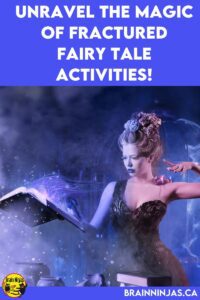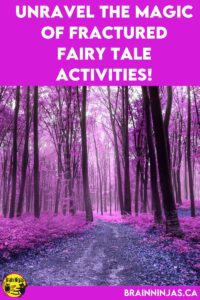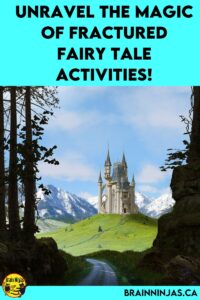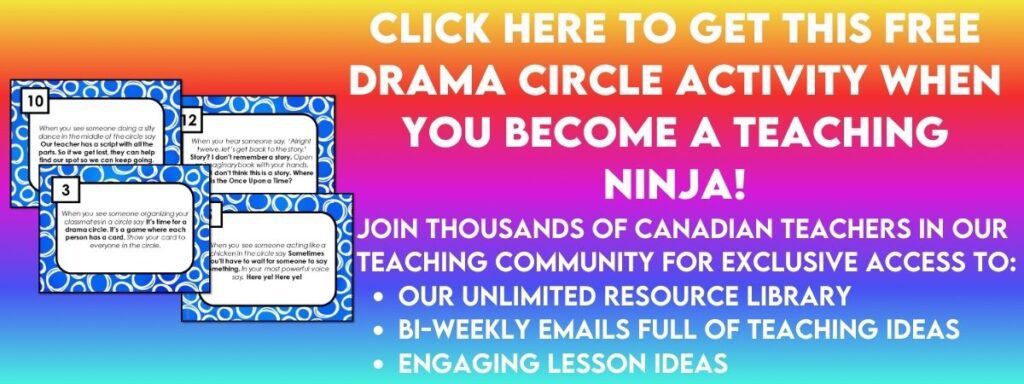
Once upon a time, there was a teacher who discovered her students didn’t know the story of Little Red Riding Hood. Yes! It’s a true story. It is not a fairy tale. With each year, it is surprising that fewer and fewer students know the traditional fairy tales. It seems that reading classic stories before entering school has become less and less common at home. With the huge selection of stories, teachers just don’t have time to read them all.
Even in upper elementary, one of our favourite units is fairy tales. We start our fairy tale unit by reading some of the old classics. If you have older students who are a little twisty, you can even share the darker versions. We talk about why fairy tales were used by parents and how the stories have changed over time. Come learn about how we use fairy tales in our upper elementary classroom.
What is a Fractured Fairy Tale?

A fairy tale is a short story in the folklore genre. These stories typically feature magic, enchantments, and mythical or fanciful beings. Most fairy tales have a lesson, and they always start with “once upon a time.” Most fairy tales end with a wrapped-up story where the characters live “happily ever after.”
A fractured fairy tale takes a classic fairy tale and adds a twist, changes characters, changes the plot, changes the setting, mixes up stories, or makes it more modern. Generally thinking, it’s a story that uses elements of fairy tales to tell a new story. Good examples of movies that are fractured fairy tales are Shrek, Ever After, and Hoodwinked.
Traditionally, fairy tales were handed down orally. They expressed the culture, history, fears, and dreams of the people who told them. Some were told to children to scare them into behaving or following specific rules. Think about Hansel and Gretel. The story tells children not to wander into the woods, or they’ll be eaten by a witch.
How to Fracture a Fairy Tale
To write a fractured fairy tale, make changes to some or all of these typical fairy tale elements:
- Time: Set the story in the present or future instead of “once upon a time, a long, long time ago.”
- Location: Set the story in a different country, region, or city. Imagine Rapunzel set in Vancouver, on a cruise ship, on another planet, or the Australian outback.
- Gender: Change the gender of the main character for a new slant. Perhaps the wolf in Little Red Riding Hood is a mischievous, grumpy female!
- Ending: Keep the original elements and plot, but change the ending.
- The Cast of Characters: Have the characters from several fairy tales join the story or change the characters in the story.
- Background: Come up with the back story behind the fairy tale. Write the action before the traditional story starts. Maybe Hansel and Gretel are in the woods because Hansel lost the map.
- Moral of the Story: Change the moral of the story. Maybe instead of the moral of Little Red Riding Hood being “don’t talk to strangers,” it becomes “using a grocery delivery service is safer than asking your granddaughter to walk through the woods.”
Writing Your Own Fractured Fairy Tale

Writing can be so much fun for students. A fairy tale doesn’t need to be very long. Students can choose a story and twist it relatively easily.
Take your stories to the next level by publishing them. We had our students write the story out using Google Slides. Students thought about how much text would be on each page and split their story up. Each page left enough room to illustrate the book. We printed the slides with two to a page and cut the pages in half. We stapled it along the side. From there, students illustrated their books so we could display them for others.
Another way to write a fractured fairy tale is to write it as a play where students can act out the parts. Students could perform as live actors, make puppets, or simply read it as a Readers’ Theatre.
If you are looking for some more ways to use their writing, check out our post Challenge Your Students with Writing Activities Every Day.
Reading Fractured Fairy Tales

If you’re looking for a fractured fairy tale activity, you should try this drama circle. A drama circle is a story that is read in parts by the whole class. Instead of students having a specific part, they have a card with text that indicates what they should say or do. Each card triggers the next card until the whole story is told. They are great for developing listening skills, fluency, and expression, and they are fun to act out.
You can find our Fractured Fairy Tale Drama Circle on TpT ($USD) or our BN Shop ($CAN). It is called The Evil Robot’s Wish.
If you have never done a drama circle, we have a drama circle that teaches students how to do a drama circle. You can find it in the Resource Library if you are on our email list. If you’re not on the list yet, we can send it directly to your inbox.

If you want to learn more about how we use drama circles in the classroom, read our post Are You Missing Out on the Love of Drama Circles?
Fractured Fairy Tale Books
There are so many different fractured fairytales that this list could truly go on forever, but these are some of the ones we read regularly. We have not linked any of these books. Please support your local bookstore whenever possible.
Don’t just read books to your students so they sit and passively listen. You can teach so many language arts outcomes as you read. Check out our post to get more ideas: 15 Ways to Engage Readers During Your Read-Aloud.
Check Out These Fairy Tale Titles
Falling for Rapunzel by Leah Wilcox
The True Story of the Three Little Pigs by Jon Scieszka
The Stinky Cheese Man and Other Fairly Stupid Tales by Jon Scieszka
The Frog Prince, Continued by Jon Scieszka
The Three Silly Billies by Margie Palatini
The Three Little Pigs by Steven Kellogg
Cinder Edna by Ellen Jackson
The Three Silly Girls Grubb by John Hassett
The Very Smart Pea and the Princess-to-Be by Mini Grey
Look Out, Jack! The Giant Is Back! by Tom Birdseye
Three Little Vikings by Bethan Woollvin
Goldilocks and the Three Dinosaurs by Mo Willems
Ninja Red Riding Hood by Corey Rosen Schwartz
Too Many Pigs and One Big Bad Wolf by Davide Cali
The Three Pigs by David Wiesner
The Gingerbread Man Loose at the Zoo by Laura Murray
Cinderella and the Furry Slippers by Davide Cali
After The Fall by Dan Santat
Three Little Pugs and the Big, Bad Cat by Becky Davies
And Even More Fairy Tale Titles

Verity Fairy: Cinderella by Caroline Wakeman
Princess and the Peas by Rachel Himes
Inside the Villains by Clotilde Perrin
The Cloud Spinner by Michael Catchpool and Alison Jay
Fairy Tale Pets by Tracey Corderoy
Once Upon A Goat by Dan Richards and Eric Barclay
Interrupting Chicken by David Ezra Stein
Fern and Otto by Stephanie Graegin
The Three Little Wolves and the Big Bad Pig by Eugenios Trivizas
Look Out, Wolf! There’s a Beast in Your Book by Jude Evans
Who Pushed Humpty Dumpty? by David Levinthal
The Wolf’s Story by Toby Forward
Looking for More?
Do you have a favourite fractured fairy tale? We’d love to add it to our list. Tell us about it in the comments below.






